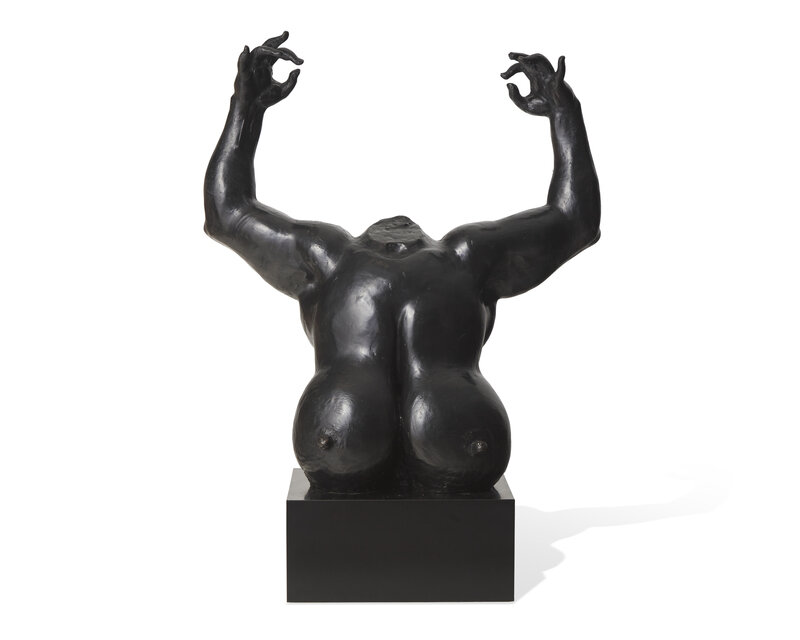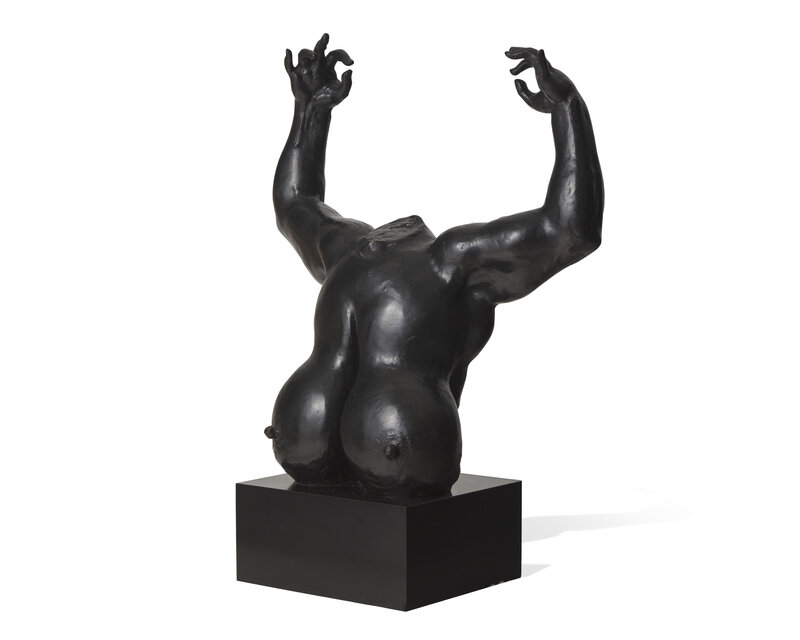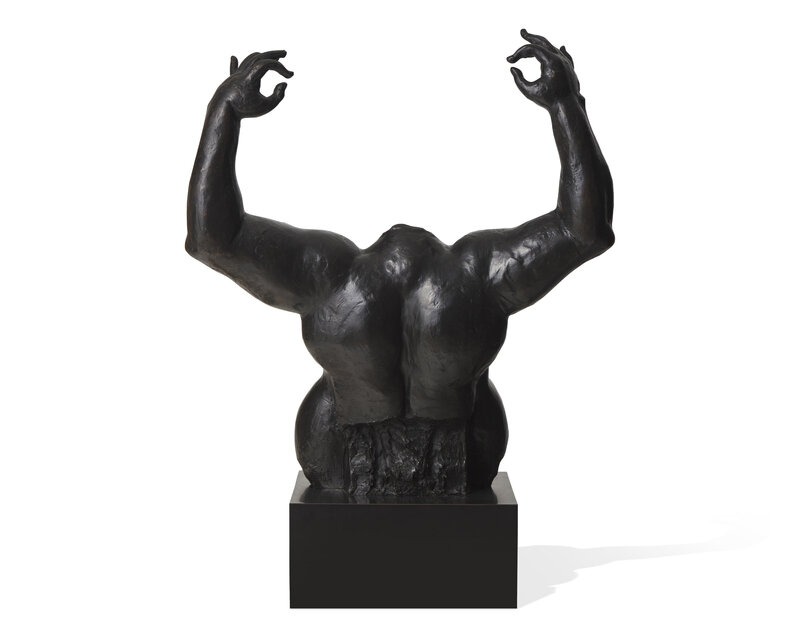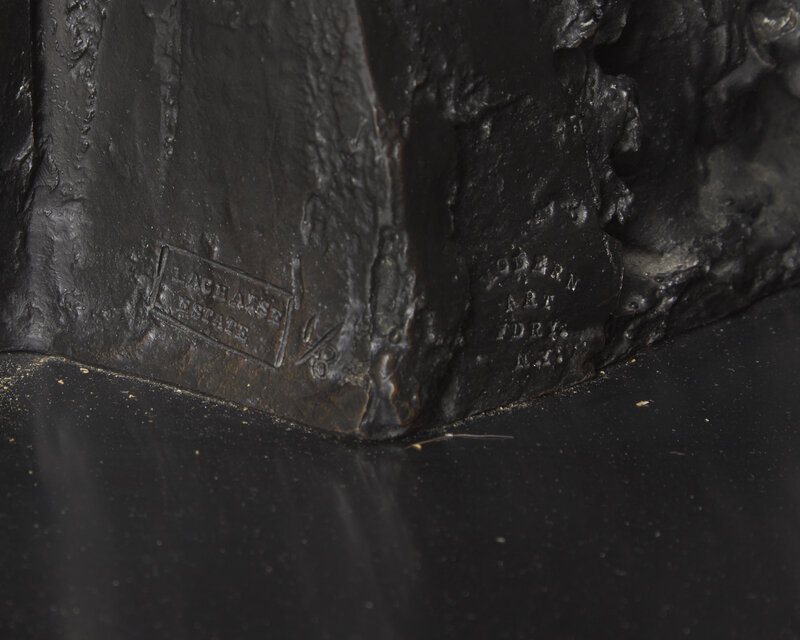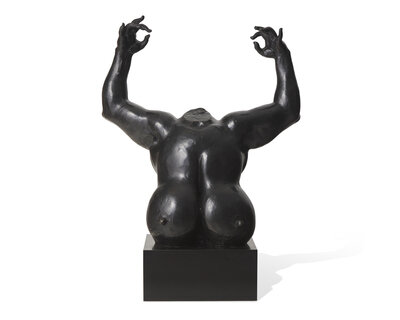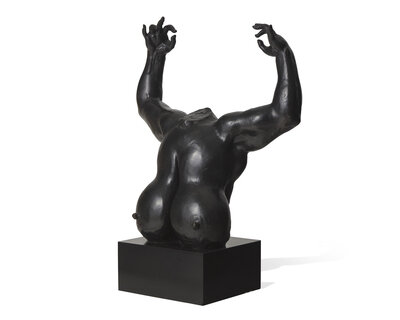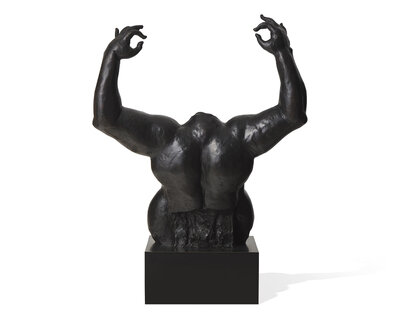Lot 22
Gaston Lachaise
(American/French, 1882-1935)
Torso with Arms Raised, 1935 [LF 106]
Sale 2104 - Post War and Contemporary Art
Nov 14, 2024
10:00AM ET
Live / New York
Own a similar item?
Estimate
$15,000 -
25,000
Price Realized
$19,685
Sold prices are inclusive of Buyer’s Premium
Lot Description
Gaston Lachaise
(American/French, 1882-1935)
Torso with Arms Raised, 1935 [LF 106]
bronze with black patina on a square black Lucite base
stamped LACHAISE/ESTATE in a cartouche and numbered 1/8 (along the base, to the right)
Model 1935; cast 1963.
Model 1935; cast 1963.
height: 36 inches.
This lot is located in Philadelphia.
Property from a Private Family Collection, New York
width: 32 1/2 inches.
depth: 16 inches.
Note:
We wish to thank Virginia Budny, author of the forthcoming Catalogue Raisonné of Lachaise’s work (sponsored by the Lachaise Foundation), for her assistance in preparing the catalogue entry for the present work.
Provenance:
Lachaise Foundation, Boston, Massachusetts.
Robert Schoelkopf Gallery, New York, New York.
Acquired directly from the above in November, 1969.
Exhibited:
Los Angeles, California, Los Angeles County Museum of Art, “Gaston Lachaise (1882–1935): Sculpture and Drawings,” December 3, 1963–January 19, 1964; traveling to New York, New York, Whitney Museum of American Art, February 18–April 5, 1964, n.p., no. 106 (illustrated in the exhibition catalogue).
New York, New York, Robert Schoelkopf Gallery, “Drawings & Sculpture by Gaston Lachaise,” February 1–19, 1966, n.p., illustrated.
Greenvale, Long Island, New York, Long Island University, C. W. Post Art Gallery, School of the Arts, C. W. Post Center, “The Long Island Art Collectors’ Exhibition: Modern Masterpieces and Contemporary Art from Long Island Art Collections,” October 24–November 23, 1975 (illustrated in the exhibition catalogue, n.p.).
Literature:
Elizabeth C. Baker, “The Late Lachaise, Uncensored at Last,” Art News, vol. 63, no. 1, March 1964, pp. 47, 67, fig. 5, illustrated.
The Sculpture of Gaston Lachaise, New York: The Eakins Press, 1967/1987, p. 53, fig. 80, illustrated.
Donald Bannard Goodall, “Gaston Lachaise, Sculptor,” 2 vols., Ph.D. dissertation, Harvard University, Cambridge, Massachusetts, 1969, vol. 1, pp. 126, 579, 590, 657n.2 (4), 662n.24, 664n.39; vol. 2, pp. 319–20, 335–36, 449, plate CXL, the plaster model mistakenly illustrated as bronze; plate CXLVIII, illustrated.
Robert Schoelkopf Gallery, Gaston Lachaise, exhibition catalogue, New York: The Gallery, 1973, n.p., another example illustrated.
Ad, Arts Magazine, vol. 48, no. 2 November 1973, p. 29, another example illustrated.
Gerald Nordland, Gaston Lachaise: The Man and His Work, New York: G. Braziller, 1974, pp. 161, 167–68, fig. 93, another example illustrated.
The Whitney Museum of American Art, 200 Years of American Sculpture, exhibition catalogue, New York:, The Museum, 1976, pp. 154, 342, fig. 213, no. 130, another example illustrated.
Rutgers University Art Gallery, The State University of New Jersey, Vanguard American Sculpture, 1913–1939,exhibition catalogue, New Brunswick, N.J.: The University, 1979, p. 156, no. 66, another example referenced.
Schoelkopf Gallery, Gaston Lachaise: Twenty Sculptures, exhibition catalogue, New York: The Gallery, 1982, another example illustrated.
Portland Museum of Art, Portland, Maine, Gaston Lachaise: Sculpture & Drawings, exhibition catalogue, Portland, Maine, The Museum, 1984, pp. 22–23, 37, no. 84, another example illustrated.
Whitney Museum of American Art, Painting & Sculpture: Acquisitions 1973–1986, New York, The Museum, 1986, p. 135, another example illustrated.
Whitney Museum of America Art at Equitable Center, American Mastery: Eight Artists in the Permanent Collection of the Whitney Museum, exhibition catalogue, New York: The Museum, 1988, pp. 5, 7, another example illustrated.
Janet Hobhouse, The Bride Stripped Bare: The Artist and The Female Nude in the Twentieth Century, London: Jonathan Cape, 1988, p. 195, plate 166, another example illustrated.
Whitney Museum of American Art Art in Place: Fifteen Years of Acquisitions, exhibition catalogue, New York: The Museum, 1989, pp. 70, 211, another example referenced.
Gaston Lachaise: Sculpture, exhibition catalogue, New York: New York, Beverly Hills. Berlin: Salander–O’Reilly Galleries; Houston: Meredith Long & Co, 1991, pp. 74–75, no. 33, 84, fig. 33, another example illustrated.
Galerie Gerald Piltzer, Gaston Lachaise Sculptures, exhibition catalogue, Paris: The Gallery, 1992, pp. 27, 60, no. 27, another example illustrated.
Sam Hunter, Lachaise, photography by David Finn, New York: Cross River Press, 1993, pp. 224–27, 245, another example illustrated.
Milton Esterow, “John McEnroe: From Center Court to Soho,” ARTnews, vol. 95, no. 4, April 1996, p. 117, another example referenced.
Salander O’Reilly Galleries, Gaston Lachaise (1982–1935): Sculpture and Drawings, exhibition catalogue, New York: The Galleries, 1998, n.p., no. 45, another example illustrated.
Gaston Lachaise, 1882–1935, exhibition catalogue, Paris: Gallimard, 2007 (English edition), front cover, pp. 32, 189, no. 75, plate 18, another example illustrated.
Rodin and America: Inspiration and Adaptation, 1876–1936, Stanford, California: Iris & B. Gerald Cantor Center for Visual Arts, Stanford University; Milan, Italy: Silvana Editoriale, 2011, pp. 145, 146, 359, fig. 160, another example illustrated, mistakenly as the first in an edition of 8 casts, cast 1965 (it is the third, cast in 1973).
Julia Day, Jens Stenger, Katherine Eremin, Narayan Khandekar, and Virginia Budny, , Gaston Lachaise: Characteristics of His Bronze Sculpture, Cambridge, Mass.: Straus Center for Conservation and Technical Studies, Harvard Art Museums, 2012, pp. viii, 29–31, 30, 65, another example referenced, mistakenly dated 1963 (it was cast in 1969).
Virginia Budny, “Provocative Extremes: Gaston Lachaise’s Women,” Sculpture Review, vol. 63, no. 2 (n.s. 14, no. 2), Summer 2014, p. 19, the plaster model illustrated.
Lot Essay:
Gaston Lachaise’s extraordinary Torso with Arms Raised [LF 106] continues to astonish sixty-nine years after it was created. The life-size sculpture represents the headless upper body of a nude woman whose arms are upraised and hands gesticulate inarticulately, and whose large, weighty breasts rest on the sculpture’s base, as though helping to support the torso. The neck had been excised just above the jugular notch: the marks of a cutting tool are clearly visible. Nonetheless, the sculpture, based on his wife’s body at age sixty-three, seems strangely alive. At the same time, its intended purpose and meaning remain unclear.
According to Lachaise’s widow, Isabel Duteau (or Dutaud) (1872–1957), the sculpture is one of the last works that her husband was creating at the time of his unexpected death in New York City in October 1935, and it had been left in his studio across the street from the Lachaises’ home in Georgetown, Maine, where he had visited as recently as late August (or possibly again in September). At the widow’s request, Lincoln Kirstein, Lachaise’s friend and patron, ordered a mold of the original model, probably made of clay or Plasticine (and no longer extant), to be made by workmen from the Ettl Studios, New York City, and then used by them to make a plaster cast from the mold. Afterward, the mold for Torso with Arms Raised (this title is posthumous) was used to make a plaster model, and in 1937, Lachaise’s widow courageously selected the model for inclusion in Lachaise’s memorial exhibition at the Whitney Museum of American Art, New York, in 1937, where the sculpture was shown simply as Torso. It is one of the first of Lachaise’s more ‘extreme’ sculptures to be presented to the public, and critics, evidently stupefied, unanimously refrained from mentioning it. The work did not appear again until the present bronze cast was included in Lachaise’s retrospective held at the Los Angeles County Museum of Art in 1963–1964 and then at the Whitney Museum in 1964.
Kirstein’s discussion of some of Lachaise’s later works in his introductory essay for the catalogue for the sculptor’s retrospective exhibition at the Museum of Modern Art, New York, in early 1935, refers to examples comparable to Torso with Arms Upraised and provides a general context for approaching this unusual, disturbing sculpture:
"In his own studio at present there are a number of pieces in plaster and bronze which have not been included …. Lachaise feels these works to be of paramount importance to himself and to the world’s knowledge of him as an artist. If they were to be shown today, however, they might give offense and precipitate scandal obscuring the importance of the rest of his creation. He is proud of these works and he is not afraid of scandal, and he believes that the original elements in these sculptures will have a healthful effect when they are courageously displayed in a favorable setting. The elements characterizing these works are not new to him. But in them his previous tendencies have been pushed so far as to constitute almost a new revelation. He has fixed in these works heroic incarnations of flesh so violent, so disturbing, that for some time to come they can only provoke wonder. "
Lincoln Kirstein, “Gaston Lachaise,” in Gaston Lachaise: Retrospective Exhibition, January 30–March 7, 1935, exhibition catalogue, New York: Museum of Modern Art, New York, 1935, p. 17)
The MoMA catalogue included only one of Lachaise’s more advanced sculptures (no. 56, Woman [LF 147], not illustrated), which appears remarkably unchallenging in comparison with Torso with Arms Raised, but was nonetheless censored and pulled from the show at the last minute. Like Torso with Arms Raised, that statuette appeared in Lachaise’s 1937 show at the Whitney, but was immediately stolen, presumably by an overwhelmed visitor. As for Torso with Upraised Arms, it has continued to confound its audience.
The Lachaise Foundation, which owns the plaster model for Torso with Upraised Arms, issued an edition of eight numbered Estate bronze casts. Thus far, six have been produced from the model between 1963 (the present example) and 1992. The second, cast in 1969, is owned by the Whitney; the third, cast in 1973, by the Lachaise Foundation, and the fifth, cast in 1992, by the Nasher Museum of Art at Duke University, Durham, North Carolina. The Lachaise Foundation has given the identifying number LF 106 to the work.
Condition Report
Contact Information
Auction Specialist
